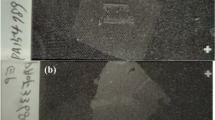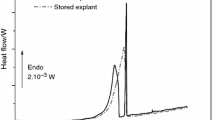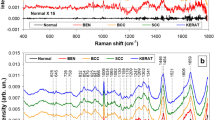Abstract
Keloid disease (KD) is a quasineoplastic fibroproliferative tumour of unknown origin causing a progressive, recurrent dermal lesion. KD is not homogeneous in nature and shows phenotypic structural differences between its distinct peripheral margins compared to its centre. The keloid margin is often symptomatically more active with increased dermal cellularity, compared to a symptomatically dormant and hypocellular centre of lesion. The aim of this study was to delineate the morphological components of a keloid scar tissue by measuring the differences between various anatomical locations within the keloid tissue, such as the margin and the centre of the lesion compared to its surrounding normal skin using Fourier transform infrared (FT-IR) microspectroscopy. FT-IR microspectroscopy is a technique that produces spectra with detailed molecular biochemical information inherent of the chemical structure. Chemical maps were constructed on extralesional cross sections taken from six keloid scars. H&E stained sections were used to confirm diagnosis of keloid and orientate the experimental cross sections prior to FT-IR. Spectral band assignment and principal components analysis were conducted. Distinct vibrational bands (100 spectra) were observed using FT-IR spectroscopy. Partial least squares discriminant analysis, with bootstrapping (10,000 analyses), identified whether a spectrum was from the keloid or normal tissue showing an average accuracy of 84.8%, precision of 80.4%, specificity of 76.2%, and sensitivity of 92.9%. FT-IR microspectroscopy showed significant differences in spectral profiles in keloid tissue in different anatomical locations within the cross section. We believe that this proof-of-concept study may help substantiate the use of FTIR spectroscopy in keloid diagnosis and prognosis.







Similar content being viewed by others
References
Bayat A, Arscott G, Ollier WER, Ferguson MWJ, Mc Grouther DA (2004) Description of site-specific morphology of keloid phenotypes in an Afrocaribbean population. Br J Plast Surg 57:122–133
Bayat A, McGrouther DA, Ferguson MWJ (2003) Skin scarring. Br Med J 326:88–92
Beausang E, Floyd H, Dunn KW, Orton CI, Ferguson MWJ (1998) A new quantitative scale for clinical scar assessment. Plast Reconstr Surg 102:1954–1961
Broadhurst D, Kell DB (2006) Statistical strategies for avoiding false discoveries in metabolomics and related experiments. Metabolomics 2:171–196
Brown BC, McKenna SP, Siddhi K, McGrouther DA, Bayat A (2008) The hidden cost of skin scars: quality of life after skin scarring. J Plast Reconstr Aesthet Surg 61:1049–1058
Brown JJ, Bayat A (2009) Genetic susceptibility to raised dermal scarring. Br J Dermatol 161:8–18
Durani P, Bayat A (2008) Levels of evidence for the treatment of keloid disease. J Plast Reconstr Aesthet Surg 61:4–17
Ellis DI, Dunn WB, Griffin JL, Allwood JW, Goodacre R (2007) Metabolic fingerprinting as a diagnostic tool. Pharmacogenomics 8:1243–1266
Ellis DI, Goodacre R (2006) Metabolic fingerprinting in disease diagnosis: biomedical applications of infrared and Raman spectroscopy. Analyst 131:875–885
Fabian H, Thi NAN, Eiden M, Lasch P, Schmitt J, Naumann D (2006) Diagnosing benign and malignant lesions in breast tissue sections by using IR-microspectroscopy. Biochim Biophys Acta Biomembr 1758:874–882
Fernandez DC, Bhargava R, Hewitt SM, Levin IW (2005) Infrared spectroscopic imaging for histopathologic recognition. Nat Biotechnol 23:469–474
Gouraund H (1971) Continuous shading of curved surfaces. IEEE Trans Comput C-20:623–629
Hollywood K, Brison DR, Goodacre R (2006) Metabolomics: current technologies and future trends. Proteomics 6:4716–4723
Jolliffe IT (1986) Principal component analysis. Springer, New York
Lasch P, Haensch W, Naumann D, Diem M (2004) Imaging of colorectal adenocarcinoma using FT-IR microspectroscopy and cluster analysis. Biochim Biophys Acta Mol Basis Dis 1688:176–186
Lewis EN, Treado PJ, Reeder RC, Story GM, Dowrey AE, Marcott C, Levin IW (1995) Fourier transform spectroscopic imaging using an infrared focal-plane array detector. Anal Chem 67:3377–3381
Martens H, Naes T (1989) Multivariate calibration, 1st edn. Wiley, Chichester
Martens H, Nielsen JP, Engenlsen SB (2003) Light scattering and light absorbance separated by extended multiplicative signal correction. Application to near-infrared transmission analysis of powder mixtures. Anal Chem 75:394–404
Patel SA, Currie F, Thakker N, Goodacre R (2008) Spatial metabolic fingerprinting using FT-IR spectroscopy: investigating abiotic stresses on Micrasterias hardyi. Analyst 133:1707–1713
Seifert O, Mrowietz U (2009) Keloid scarring: bench and bedside. Arch Dermatol Res 301:259–272
Shih B, Bayat A (2010) Genetics of keloid scarring. Arch Dermatol Res 302:319–339
Shih B, Garside E, McGrouther DA, Bayat A (2010) Molecular dissection of abnormal wound healing processes resulting in keloid disease. Wound Repair Regen 18:139–153
Sulé-Suso J, Skingsley D, Sockalingum GD, Kohler A, Kegelaer G, Manfait M, El Haj AJ (2005) FT-IR microspectroscopy as a tool to assess lung cancer cells response to chemotherapy. Vib Spectrosc 38:179–184
Tan KT, Shah N, Pritchard SA, McGrouther DA, Bayat A (2010) The influence of surgical excision margins on keloid prognosis. Ann Plast Surg 64:55–58
Westerhuis JA, Hoefsloot HCJ, Smit S, Vis DJ, Smilde AK, van Velzen EJJ, van Duijnhoven JPM, van Dorsten FA (2008) Assessment of PLSDA cross validation. Metabolomics 4:81–89
Acknowledgments
We would like to acknowledge the support of the following organizations for this study: NIHR (UK). In addition we would like to specially thank the GAT Family Foundation, and Steve and Kathy Fitzpatrick for generous funding and support. K.A.H. thanks Stiefel Laboratories (U.K.) Ltd. for her studentship and R.G. is very thankful to UK BBSRC for funding.
Conflict of interest
The authors state no conflict of interests.
Author information
Authors and Affiliations
Corresponding author
Rights and permissions
About this article
Cite this article
Hollywood, K.A., Maatje, M., Shadi, I.T. et al. Phenotypic profiling of keloid scars using FT-IR microspectroscopy reveals a unique spectral signature. Arch Dermatol Res 302, 705–715 (2010). https://doi.org/10.1007/s00403-010-1071-2
Received:
Revised:
Accepted:
Published:
Issue Date:
DOI: https://doi.org/10.1007/s00403-010-1071-2




